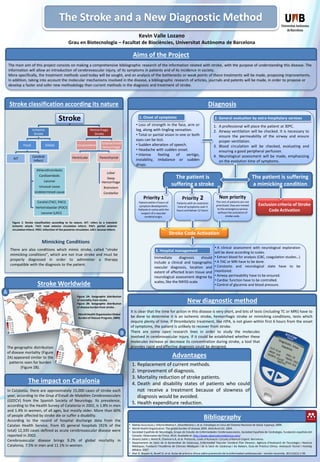
TFG_kevinvallelozano
- 1. Stroke Ischemic Stroke Focal AIT Cerebral Infarct Atherothrombotic Cardioembolic Lacunar Unusual cause Undetermined cause Carotid (TACI, PACI) Vertetrobasilar (POCI) Lacunar (LACI) Global Hemorrhagic Stroke Intracerebral Parenchymal Lobar Deep Hemorrhage Brainstem Cerebellar Ventricular Subarachnoid hemorrhage The Stroke and a New Diagnostic Method The main aim of this project consists on making a comprehensive bibliographic research of the information related with stroke, with the purpose of understanding this disease. The information will allow an introduction of cerebrovascular injury, of its symptoms in patients and of its incidence in society. More specifically, the treatment methods used today will be sought, and an analysis of the bottlenecks or weak points of these treatments will be made, proposing improvements. In addition, taking into account the molecular mechanisms involved in the disease, a bibliographic research of articles, journals and patents will be made, in order to propose or develop a faster and safer new methodology than current methods in the diagnosis and treatment of stroke. Figure 2A: Geographic distribution of mortality from stroke . Figure 2B: Geographic distribution of disease burdenfrom stroke . (World Health Organization Global Burdenof Disease Program, 2004) Figure 1: Stroke classification according to its nature. AIT: refers to a transient ischemic attack. TACI: total anterior circulation infarct. PACI: partial anterior circulation infarct. POCI: infarction of the posterior circulation. LACI: lacunarinfarct. There are also conditions which mimic stroke, called “stroke mimicking conditions”, which are not true stroke and must be properly diagnosed in order to administer a therapy compatible with the diagnosis to the patient. Mimicking Conditions 1. Onset of symptoms • Loss of strength in the face, arm or leg, along with tingling sensation. • Total or partial vision in one or both eyes can be lost. • Sudden alteration of speech. • Headache with sudden onset. • Intense feeling of vertigo, instability, imbalance or sudden drops. 2. General evaluation by extra-hospitalary services 1. A professional will place the patient at 30ºC. 2. Airway ventilation will be checked. It is necessary to ensure the permeability of the airway and ensure proper ventilation. 3. Blood circulation will be checked, evaluating and ensuring a good peripheral perfusion. 4. Neurological assessment will be made, emphasizing on the evolution time of symptoms. The patient is suffering a stroke The patient is suffering a mimicking condition Priority 1 Patientwithin 4 hours of symptom development. Patients in coma with the suspect of a vascular cerebralorigin. Priority 2 Patients with an evolution timeof symptoms over 4 hours and below 12 hours. Non priority The rest of patients are not prioritized.they are moved to the emergency service without the activationof stroke code. Stroke Code Activation Exclusion criteria of Stroke Code Activation DiagnosisStroke classification according its nature Stroke Worldwide In Catalonia, there are approximately 15,000 cases of stroke each year, according to the Grup d’Estudi de Malalties Cerebrovasculars (GEECV) from the Spanish Society of Neurology. Its prevalence, according to the Health Survey of Catalonia in 2002, is 1.8% in men and 1.4% in women, of all ages, but mostly older. More than 60% of people affected by stroke die or suffer a disability. According to the record of hospital discharge data from the Catalan Health Service, from 65 general hospitals (91% of the total) 12,335 cases defined as acute cerebrovascular disease were reported in 2002. Cerebrovascular disease brings 9.2% of global mortality in Catalonia; 7.5% in men and 11.1% in women. 3. Hospital management Immediate diagnosis should include a clinical and topographic vascular diagnosis, location and extent of affected brain tissue and neurological assessment degree by scales, like the NIHSS scale. • A clinical assessment with neurological exploration will be done according to scales. • Extract blood for analysis (CBC, coagulation studies…) • A TAC or MRI have to be done. • Constants and neurological state have to be monitored. • Airway permeability have to be ensured. • Cardiac function have to be controlled. • Control of glycemia and blood pressure. The impact on Catalonia The geographic distribution of disease mortality (Figure 2A) appeared similar to the patterns seen for burden (Figure 2B). New diagnostic method A B It is clear that the time for action in this disease is very short, and lots of tests (including TC or MRI) have to be done to determine it is an ischemic stroke, hemorrhagic stroke or mimicking conditions, tests which require plenty of time. If thrombolytic treatment, like rtPA, is not given within first 6 hours from the onset of symptoms, the patient is unlikely to recover from stroke. Advantages 1. Replacement of current methods. 2. Improvement of diagnosis. 3. Mortality reduction of stroke patients. 4. Death and disability states of patients who could not receive a treatment because of slowness of diagnosis would be avoided. 5. Health expenditure reduction. • Matías-GuiuGuia J, VilloriaMedina F, OlivaMoreno J, et al. Estrategia en Ictus del Sistema Nacional de Salud. Espanya; 2009. • World Health Organization.The global burden of disease 2004. Glob Burd Dis. 2004. • Sociedad Española de Neurología, Grupo de Estudio de Enfermedades Cerebrovasculares, Sociedad Española de Cardiología, Fundación española del Corazón. Observatori de l’Ictus. 2014. Availableat: http://www.observatoriodelictus.com/. • Alvarez Sabin J, Belvis R, Chamorro À, et al. Protocols, Codis d’Activació i Circuits d'Atenció Urgent. Barcelona. • Departament de Salut de la Generalitat de Catalunya, Enfermedad Vascular Cerebral Plan Director, Agència d’Avaluació de Tecnologia i Recerca Mèdiques, Fundació l’Acadèmia de Ciències Mèdiques i de la Salut de Catalunya i les Balears. Guía de Práctica Clínica. Avaluació Tecnol i Investig Mèdica. 2007. • Atar D, Boysen G, Burell G, et al. Guías de práctica clínica sobre prevención de la enfermedad cardiovascular : versión resumida. 2011;61(1):1-50. Bibliography Aims of the Project Kevin Valle Lozano Grau en Biotecnologia – Facultat de Biociències, Universitat Autònoma de Barcelona There are some open research lines in order to study the molecules involved in cerebrovascular injury. If it could be established whether these molecules increase or decrease its concentration during stroke, a tool that provides rapid and effective diagnosis could be designed.